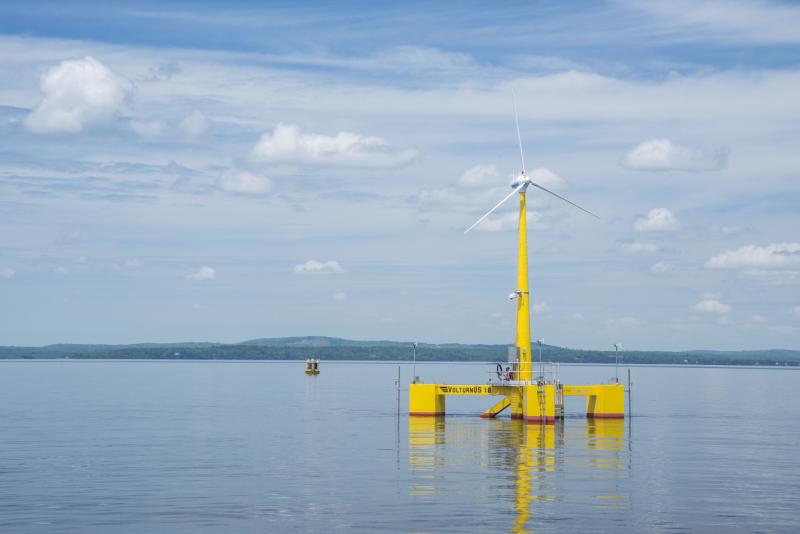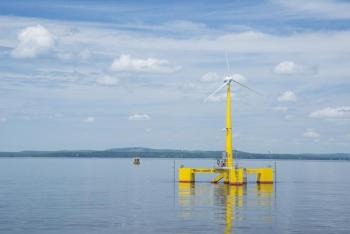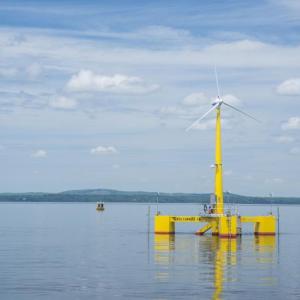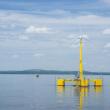New England Aqua Ventus moving forward with turbine
New England Aqua Ventus (NEAV), formerly known as Maine Aqua Ventus, will soon begin ramping up efforts to put a single 10-12 megawatt turbine about two miles south of Monhegan Island. The project seeks to lay over 20 miles of cable several feet under the ocean floor from East Boothbay shores to the site.
The floating semisubmersible hull is a University of Maine Advanced Structures and Composites Center design patented as VolturnUS. The UMaine-based researchers and engineers constructed and ran a 1:8, one-to-eight, version of a six megawatt turbine off the coast of Castine.
The project scored $39.9 million in U.S. Department of Energy research and development funds beating out 70 other public and private projects; however, the project cost, about $100 million, and other snags along the way kept the project relatively dormant until Gov. Janet Mills signed a law in November 2019 directing Maine Public Utilities Commission to approve the project’s contract. This paved the way for Aqua Ventus to sign a 20-year power-purchase agreement at above-market rates with Central Maine Power.
When the project rebranded in August 2020 as NEAV, partnering UMaine with Mitsubishi subsidiary Diamond Offshore Wind and German utilities giant RWE Renewables, the two-turbine project morphed into a singular larger one. Since then, NEAV has waited for the COVID-19 pandemic to quiet down before attacking the project in earnest and connecting with the coastal and fishing communities.
Diamond Offshore Wind CEO Chris Wissemann said NEAV was poised to roll out the upcoming stages of the project as soon as about a year ago. Ever since, he said the project has been put on hold month to month until it was finally decided to simply roll it out in remote meetings.
Said Wissemann, “What brings us really into Boothbay is that the project … needs some support services from the coast, so we're planning to bring the electric cable into Boothbay … but we’re also working with some of the local folks to ultimately provide operations and maintenance services. So, we would be putting jobs in Boothbay.”
NEAV consultant David Wilby said with offshore wind about to take off in the northeast with hundreds, perhaps thousands, of turbines slated for installation from New Hampshire to Virginia, the NEAV project will play heavily into the future of offshore wind in the bigger picture, and economically at the more local level. Said Wilby, “At least half the value of this construction and components are going to come out of Brewer and Searsport and are going to be built and assembled by companies that have very familiar names to (Mainers). So, the vast majority of work is going to happen in Maine with Mainers doing it.”
If all goes to plan, land-based construction will likely start in 2022 and cable work will begin in the winter of 2022 and 2023, said Wissemann. The turbine will be towed out to Monhegan and moored in place during the summer of 2023. NEAV has hired Texas-based firm Fugro USA Inc. to conduct the geophysical and geotechnical seabed survey from March 8 to April 4. Wissemann said the survey will begin in East Boothbay and will move eastward toward Monhegan and the aim of the survey is to find exactly where cable can be laid down and buried no less than three to five feet below the seabed.
Said Wissemann, “If we do all this right, we can have lots of people go to work building this stuff … demonstrating University of Maine technology and showing that it can be built here in Maine. That's the whole crux of why we signed aboard to try and help the state do … Those are the goals, to prove this homegrown foundation works, that it can be built locally, that you can make the jobs people have talked about and secondarily, for this one little project, is just to see what it's like to fish nearby.”
Event Date
Address
United States























